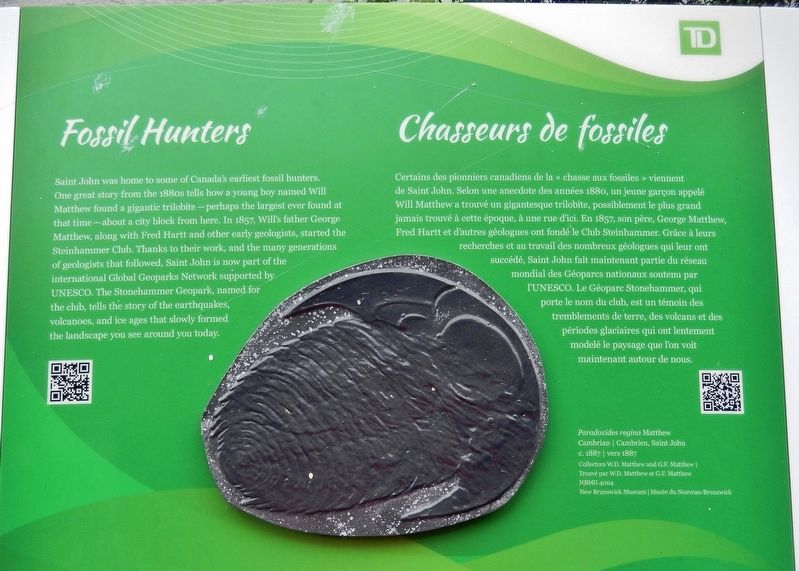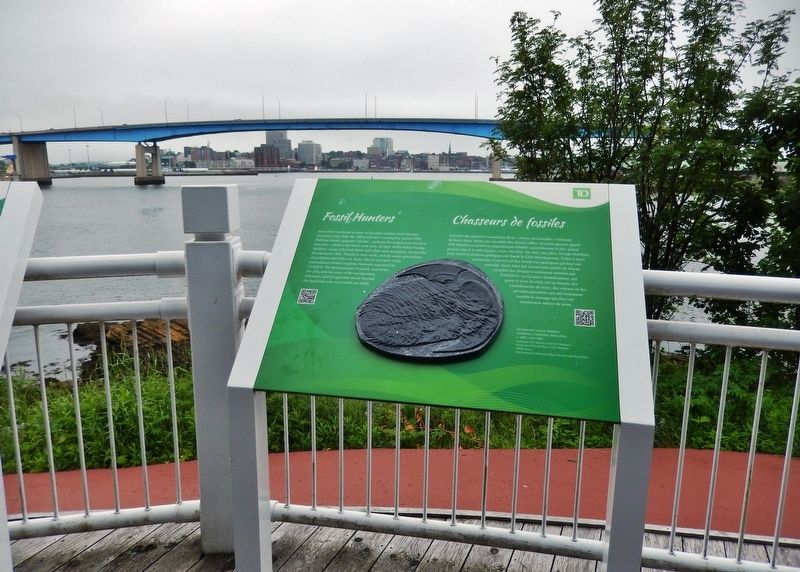Saint John in Saint John County, New Brunswick — The Atlantic Provinces (North America)
Fossil Hunters
Chasseurs de fossiles
Saint John was home to some of Canada's earliest fossil hunters. One great story from the 1880s tells how a young boy named Will Matthew found a gigantic trilobite — perhaps the largest ever found at that time about a city block from here. In 1857, Will's father George Matthew, along with Fred Hartt and other early geologists, started the Steinhammer Club. Thanks to their work, and the many generations of geologists that followed, Saint John is now part of the international Global Geoparks Network supported by UNESCO. The Stonehammer Geopark, named for the club, tells the story of the earthquakes, volcanoes, and ice ages that slowly formed the landscape you see around you today.
Certains des pionniers canadiens de la « chasse aux fossiles » viennent de Saint John. Selon une anecdote des années 1880, un jeune garçon appelé Will Matthew a trouvé un gigantesque trilobite, possiblement le plus grand jamais trouvé à cette époque, à une rue d'ici. En 1857, son père, George Matthew, Fred Hartt et d'autres géologues ont fondé le Club Steinhammer. Grâce à leurs recherches et au travail des nombreux géologues qui leur ont succédé, Saint John fait maintenant partie du réseau mondial des Géoparcs nationaux soutenu par l’UNESCO. Le Géoparc Stonehammer, qui porte le nom du club, est un témoin des tremblements de terre, des volcans et des périodes glaciaires qui ont lentement modelé le paysage que l'on voit maintenant autour de nous.
(photo caption)
Paradoxides regina Matthew
Cambrian │ Cambrien, Saint John,
c. 1887 │ vers 1887
Collectors W.D. Matthew and G.F. Matthew │
Trouvé par W.D. Matthew et G.F. Matthew
NBMG 4004
New Brunswick Museum │ Musée du Nouveau-Brunswick
Topics. This historical marker is listed in this topic list: Paleontology. A significant historical year for this entry is 1857.
Location. 45° 16.08′ N, 66° 4.693′ W. Marker is in Saint John, New Brunswick, in Saint John County. Marker can be reached from the intersection of Chesley Drive (New Brunswick Route 100) and Bentley Street, on the right when traveling north. Marker is located along the Harbour Passage Trail, at the Bentley Street trailhead. Touch for map. Marker is in this post office area: Saint John NB E2K 1B2, Canada. Touch for directions.
Other nearby markers. At least 8 other markers are within walking distance of this marker. Ancient Life (here, next to this marker); Navy Island (Ouigoudy Island) (about 240 meters away, measured in a direct line); Fishing the Harbour (about 240 meters away); The Saint John Harbour Bridge | Le pont du port de Saint John (approx. 0.4 kilometers away); The Tides of Fundy (approx. 0.4 kilometers away); The Shards of Time (approx. 0.6 kilometers away); Fort La Tour (approx. 0.7 kilometers away); a different marker also named Fort La Tour (approx. 0.7 kilometers away). Touch for a list and map of all markers in Saint John.
Also see . . . George Matthew. George Matthew lived in Saint John at a time when the city was a busy port and an important centre in eastern Canada. Even though Matthew did not attend university, the intellectual atmosphere in Saint John supported his interest in natural history, and its complicated geology challenged his curiosity. By the 1890s Matthew had made himself a well-established member of the geoscience community, although still an amateur. Matthew described more than 350 new species of fossil plants and animals. (Submitted on April 9, 2020, by Cosmos Mariner of Cape Canaveral, Florida.)
Credits. This page was last revised on November 3, 2022. It was originally submitted on April 7, 2020, by Cosmos Mariner of Cape Canaveral, Florida. This page has been viewed 93 times since then and 4 times this year. Photos: 1, 2. submitted on April 9, 2020, by Cosmos Mariner of Cape Canaveral, Florida.

